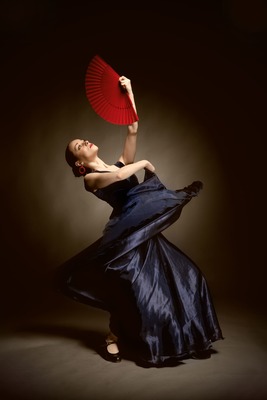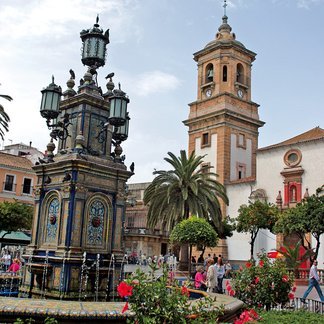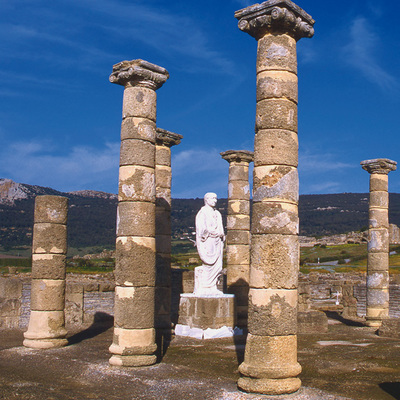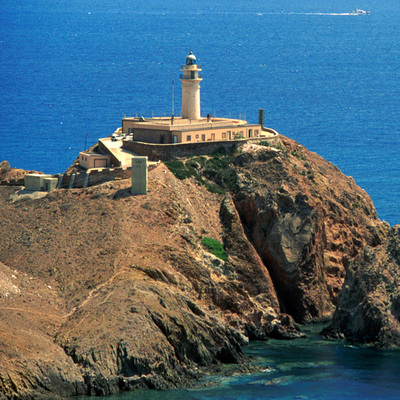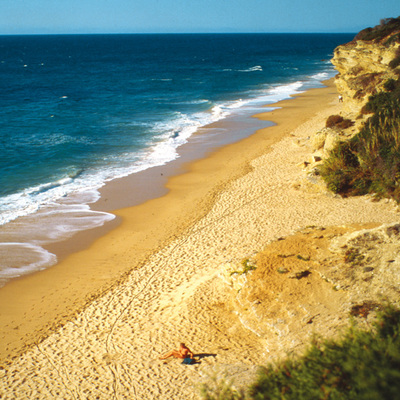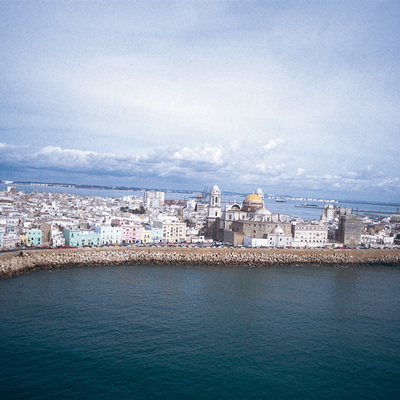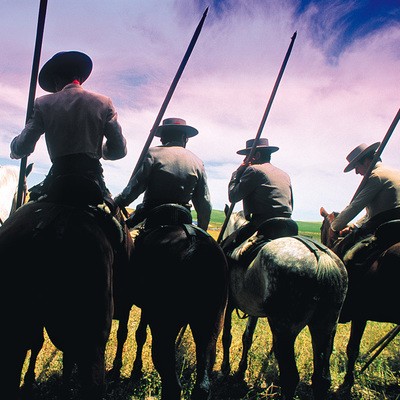The three-four time route. The basic song types
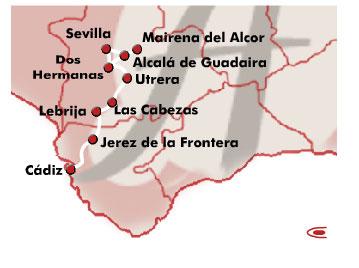
Triana is one of the cradles of flamenco. The genesis of jonda (deep) flamenco occurred in the triangle formed by Triana, Jerez and Cadiz. A twisting path, which will bring us a deep understanding of the essence of the cabales style.
El Altozano is a square at the heart of La Cava avenue in Triana. A few metres away is the Tío José Tavern, an old sanctuary of flamenco singing and for lovers of bullfighting. Flamenco is always present, including hundreds of photographs of artists from all eras, and it is blessed with the live presence of masters from our own times living in Seville. Just a few metres away, in Pagés del Corro street is the Don Cecilio de Triana Flamenco Gathering, where local enthusiasts flamenco get together every Thursday to talk about the legendary soleá and toná song styles that came into being in this neighbourhood two centuries ago. Next door to this association is the Casa de Anselma, a tavern in which the lighter styles of flamenco (the sevillana, rumba and copla) can be heard every night.
Continuing, we come to El Zurraque, an area of Triana that is home to the very best of the soleá alfarera style. It was here that such legendary figures as Ramón el Ollero, el viejo Abadía, the Pinea family, Curro Puya and Pepe el de la Matrona established themselves, all predecessors to artists like Manuel Oliver, El Teta, El Sordillo, Pepe el Culata, El Arenero and Márquez el Zapatero.
Triana today has cellars with deep flamenco singing and its busy shopping streets. Betis Street has many bars with live daily performance of sevillanas, tangos and bulerías.
Another nerve centre is found on La Alameda de Hércules avenue. Here, colmaos - bars with impromptu flamenco performances - like Casa Postigo, La Sacristía, Los Majarones, Casa Parrita and Las Siete Puertas were common up to middle of the 20th century. Now only the last of these remains, but the area still recalls La Niña de los Peines and her brother Tomás Pavón, Manuel Torre, El Gloria, las Pompis, Manuel Vallejo, Antonio Mairena, El Chocolate, Diego del Gastor, Niño Ricardo, Manolo de Huelva and so many others.
Another key place to visit is Utrera. Mercé La Serneta, a singer born in Jerez around 1840, came to live in this town in Seville province at an early age. Here she combined influences of singers from Jerez and Lebrija with those in Utrera to create soleá songs that today are the pride of the people of Utrera. The same approach was taken by the Pinini family to create their distinctive cantina songs by combining styles from Utrera and Lebrija.
Another two legends from the history of flamenco singing: La Fernandaand La Bernarda, who together with the Perrate family represent the basis of recent flamenco in the town area. This set of circumstances led to the creation of the first flamenco festival in history, the Potaje Gitano festival, held every summer in the courtyard of the Salesian College. Gatherings are also common in the central district in remembrance of famous singers of the past from Utrera, such as Bambino, Enrique Montoya and family, Manuel de Angustias, Gaspar, Pepa de Benito and Curro de Utrera, the latter being the name taken by the local flamenco association that organizes another festival: El Mostachón.
Next stop: Jerez de la Frontera. The Santiago and San Miguel neighbourhoods are the two main flamenco strongholds, out of which came Manuel Torre and Antonion Chacón. However, the best place to start the visit is the Andalusia Flamenco Centre, located in the Palacio de Pemartín mansion. Here you can consult thousands of sound, written and audiovisual documents on flamenco art and find out about all the activities held each season in the different flamenco associations of Jerez.
As well as these places, you must also visit the typical taverns, such as Arco de Santiago and Lagar de Tío Parrilla, in order to gain a clear appreciation of the contribution made to the seguiriyas form by the legendary figures of Paco la Luz, El Marruro, Manuel Molina, El Sernita, Juan Mojama and Terremoto. At the same time, many singers came from the area's old forges, including important figures like Agujetas el Viejo and Tío José de Paula. There are also two momentous occasions not to be missed: the annual Festival of Jerez in the Teatro Villamarta and the Bulería Festival. The latter is held in the summer in the bullring, accompanied by portions of fried fish and rounds of local songs and clapping.
In Lebrija we must not overlook two of the greats: Diego el Lebrijano and Juaniquín de Lebrija. Today's flamenco scene in Lebrija is dominated by the Peña and Bacán families. Other artists, like El Lagaña, José Vargas, Antonia Pozo, La Rumbilla, La Perrengue, La Morena and El Chozas, can also be added to the list of masters from the land of Elio Antonio. The leading figure today is Juan Peña El Lebrijano, while other important figures include his brother Pedro, the guitarist Pedro Bacán, the dancer Concha Vargas, Miguel el Funi, Curro Malena, Manuel de Paula and the very young José Valencia. All of these can be seen frequently at the Pepe Montaraz flamenco association and houses in the surrounding area, as well as at the Fernando el Herrero flamenco association in Cabezas de San Juan. The great event of the year in Lebrija is the famous Caracolá festival, in which, when the officially programmed event ends, the improvised clapping and dancing begins.
Cadiz, a more liberal flamenco movement. We should start in Santa María to form an idea of what this final stretch of the journey holds. This is where the legendary figure of Enrique el Mellizo forged his art. However, he was not the only master from Cadiz. In the city's cemetery, a tombstone records many of the famous flamenco figures from the area: this is the tomb of Enrique el Gordo, which can be visited to gain an understanding of the copla song by Silverio. Of equal importance is the figure of Gabriel Díaz Fernández, Macandé. This flamenco singer made the unaccompanied pregón por asturianas singing style - which he sung to sell sweets - popular in Cadiz.
All of these influences helped to nurture artists like Ignacio Espeleta, Pericón de Cádiz and Aurelio Sellés, standard-bearers of the alegrías song style and singers closely related to another essential reference point for visitors in search of flamenco: the Cadiz Carnival, which takes place in February each year. At this time a charming place to visit is Pericón street in the La Viña neighbourhood, where you can be reminded of the festive bulerías style of Antonia La Perla, listen to Felipe Escapachini sing cantiñas songs in the Juan Villar flamenco association, or listen to Juan Villar himself with Mariana Cornejo performing local songs accompanied by clapping....
The American styles appeared in the area of Caleta beach. Guajiras, milongas, vidalitas and rumbas were sung by Pepe Marchena - who went on to invent the colombianas style - and by Manuel Escacena, Vallejo, Pastora and many others whose presence can still be felt on Playa de la Victoria beach.
Alcalá de Guadaira received many gypsy families from Triana, among which Los Gordos family was of great importance. The leader of this dynasty was undoubtedly Joaquín el de la Paula, who is so often named in local soleá songs. This place provided influences to subsequent singers from the family, such as Manolito de María, who made famous a peculiar Our Father prayer in the bulerías style, and the Talega division of the family, headed by Agustín el Gordo.
Other artists from Alcalá not to be forgotten are Bernardo el de los Lobitos and Platero de Alcalá. Agustín el Gordo was oldest representative of this family and it was he who moved the family to Dos Hermanas, where he established the El Potro Tavern on Real Utrera street. This is where Juan Fernández Vargas, Juan Talega, the highly celebrated singer who gives his name to the town's flamenco association , learned his art. It is located in an old farmhouse that conserves much information about the singer and where many activities revolving around this figure take place. This singer's influence also reached Los Palacios y Villafranca, home to the famous guitarist, Eduardo de the Malena. The taverns in Los Palacios are full of discussions about flamenco, concerning its great artists, like El Rerre, Itoly, Juanito el Distinguido, the dancer El Mistela and the young Miguel Ortega.
Naturally, the town of Mairena del Alcor must also be visited in order to hear the songs of Alcalá. The best way to get to know the whole atmosphere surrounding the cabal style of Mairena is to go directly to the Antonio Mairena Flamenco Art House a place which preserves with great pride all of the information about the holder of the key to the rest of the area's flamenco artists.


